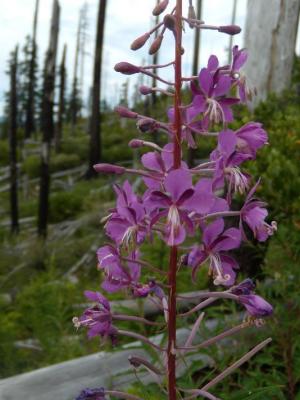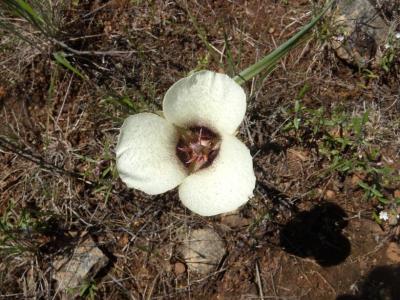Douglas County is home to an enormous array of wildflowers — some are rare, many are common. Two general conditions account for much of this diversity. The first is a Mediterranean environment, and the second is a wide diversity of habitats. Our floral habitats include rocks and cliffs, meadows, forest and the shorelines of creeks, rivers, and ponds. Wildflowers typically begin blooming in early March and continue through mid-summer, with "peak bloom" happening in May and early June. Wildflower blooms are dependent on the variety of the flower, temperature, the number of daylight hours, and the amount of moisture in the soil. Since Douglas County offers such a wide range of wildflowers, color speckles the countryside in pinks, yellows, lavenders, blues, and oranges through most of the spring and summer.
Local Favorites
Many wildflower enthusiasts have their favorites. Here are a few examples. Some of the earliest flowers you might see include Oregon fawn lilies, cut-leaved goldthread, flowering currant, Hartwig's wildginger, Indian plum, Oregon grape, Oregon fetid adder's tongue, Oregon selaginella, Marshall's saxifrage, saucer bishops cap, spring gold, violets, western wood anemone and more. Trilliums are common in the early Spring. Their three-petaled white or pink blooms are one of the early gifts of spring. Camas is a beautiful member of the lily family found in both meadows and forested areas. The bulbs were a vegetable staple of the indigenous people of Douglas County. Another lovely lily includes the fritillaria, sporting a checkerboard pattern on the petals. They are quite the lookers.
Some herbaceous perennials to look for are bleeding heart, nemophila, clarkia, globe gilia, Oregon iris, Oregon spring and spring queens.
 In meadows and forests look for yellow sand verbenas, red columbine, elegant brodiaea, fireweed (shown in photo on left), glacier lilies, scalloped onion, Cardwell’s penstemon, spreading phlox... and so many more.
In meadows and forests look for yellow sand verbenas, red columbine, elegant brodiaea, fireweed (shown in photo on left), glacier lilies, scalloped onion, Cardwell’s penstemon, spreading phlox... and so many more.
Another favorite is the adorable monkey flower, named for the “face” that can be seen in the asymmetrical flowers. The showy, tube-shaped beardtongues — in vibrant hues of yellow, pink, and purple — are photogenic as well and come in 46 varieties native to Oregon. You can find them in both wet meadows and rocky cliffs.
Later in the season look for ubiquitous daisies and asters in various hues of pinks, purples, and whites. Both grow in almost every type of environment, even backyards. Paintbrushes — in vibrant shades of red, purple, and orange — tend to grow in meadows and along roadsides. In the mountains and in some locations, the delicate white bear grass is a unique species to find.
Oregon grape, the state flower of Oregon, is an undemanding evergreen shrub with shiny, holly-like leaves. It blooms golden yellow flowers in the spring with dark blue berries that follow. Oregon grape is a favorite nectar source for bees early in the season. Other flowering shrubs include wood rose, red-flowering currant, oceanspray, western crabapple, and mock orange. Some colorful groundcovers include Kinnikinnik and wild strawberry.
Rare Wildflowers
Douglas County is also home to some rare wildflowers that occur exclusively in Douglas County. They include:
Umpqua mariposa lily: It is restricted to serpentine soils. It can be found growing in forest, meadow and ecotonal areas. Look for it around Tiller and Peel. (Shown in photo on right).
Umpqua frasera: This beautiful flower is found in meadows and in the forest at high elevations late in the season.
Kincaid's lupine: Kincaid’s lupine is found in upland prairie remnants and ecotones between grassland and the forest. Major threats to Kincaid’s lupine include habitat loss due to urbanization, agriculture, forestry practices, and roadside maintenance; competition from non-native plants; and successional encroachment by woody plants due to changes in historic disturbance regimes. The Kincaid’s lupine is listed as endangered. It is not exclusive to Douglas County.
Viewing Areas
There are plenty of great places to find wildflowers in the spring and summer months. Local trails with fantastic wildflower viewing include North Bank management habitat area, Black tail ridge and middle ridge, Susan Creek Falls, Wolf Creek falls, North Umpqua Trail and Donegan Prairie Trail. The trails of the Rogue-Umpqua divide offer some high elevation meadow and forest late floral displays.
Oregon Wildflowers, an app developed in partnership with the Oregon Flora Project at Oregon State University and High-Country Apps, can help you identify over 1,000 species of wildflower. This is a paid app, but if you don't mind investing a few bucks, you can name those flowers quickly and easily right from your phone. The app does not need an Internet connection to run, so you can use it no matter how remote your wanderings take you. The app provides images, species descriptions, range maps, bloom period, and technical descriptions.
2023 Glide Wildflower Show
If you want to learn more about wildflowers, be sure to check out the Glide Wildflower Show the weekend of April 29-30. The show features over 600 species of Southwest Oregon wildflowers, trees and shrubs, grasses, ferns lichens, and mosses. See this website for details: www.glidewildflowershow.org
